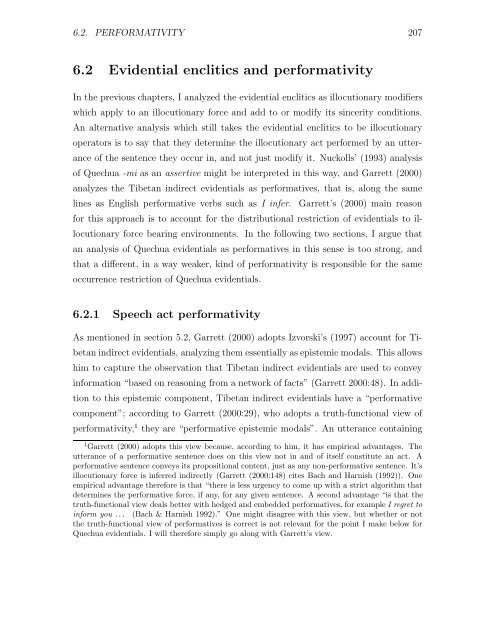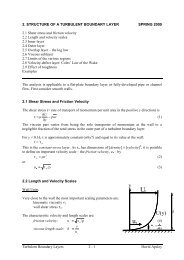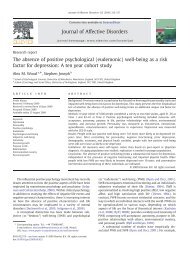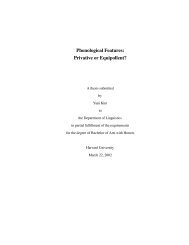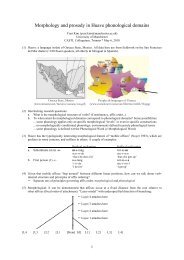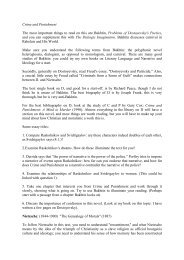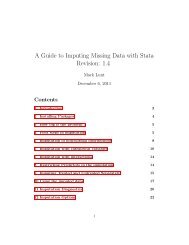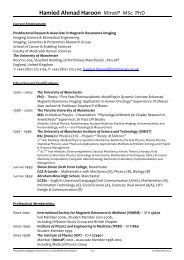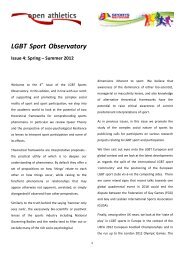semantics and pragmatics of evidentials in cuzco quechua
semantics and pragmatics of evidentials in cuzco quechua
semantics and pragmatics of evidentials in cuzco quechua
You also want an ePaper? Increase the reach of your titles
YUMPU automatically turns print PDFs into web optimized ePapers that Google loves.
6.2. PERFORMATIVITY 207<br />
6.2 Evidential enclitics <strong>and</strong> performativity<br />
In the previous chapters, I analyzed the evidential enclitics as illocutionary modifiers<br />
which apply to an illocutionary force <strong>and</strong> add to or modify its s<strong>in</strong>cerity conditions.<br />
An alternative analysis which still takes the evidential enclitics to be illocutionary<br />
operators is to say that they determ<strong>in</strong>e the illocutionary act performed by an utterance<br />
<strong>of</strong> the sentence they occur <strong>in</strong>, <strong>and</strong> not just modify it. Nuckolls’ (1993) analysis<br />
<strong>of</strong> Quechua -mi as an assertive might be <strong>in</strong>terpreted <strong>in</strong> this way, <strong>and</strong> Garrett (2000)<br />
analyzes the Tibetan <strong>in</strong>direct <strong>evidentials</strong> as performatives, that is, along the same<br />
l<strong>in</strong>es as English performative verbs such as I <strong>in</strong>fer. Garrett’s (2000) ma<strong>in</strong> reason<br />
for this approach is to account for the distributional restriction <strong>of</strong> <strong>evidentials</strong> to illocutionary<br />
force bear<strong>in</strong>g environments. In the follow<strong>in</strong>g two sections, I argue that<br />
an analysis <strong>of</strong> Quechua <strong>evidentials</strong> as performatives <strong>in</strong> this sense is too strong, <strong>and</strong><br />
that a different, <strong>in</strong> a way weaker, k<strong>in</strong>d <strong>of</strong> performativity is responsible for the same<br />
occurrence restriction <strong>of</strong> Quechua <strong>evidentials</strong>.<br />
6.2.1 Speech act performativity<br />
As mentioned <strong>in</strong> section 5.2, Garrett (2000) adopts Izvorski’s (1997) account for Tibetan<br />
<strong>in</strong>direct <strong>evidentials</strong>, analyz<strong>in</strong>g them essentially as epistemic modals. This allows<br />
him to capture the observation that Tibetan <strong>in</strong>direct <strong>evidentials</strong> are used to convey<br />
<strong>in</strong>formation “based on reason<strong>in</strong>g from a network <strong>of</strong> facts” (Garrett 2000:48). In addition<br />
to this epistemic component, Tibetan <strong>in</strong>direct <strong>evidentials</strong> have a “performative<br />
component”; accord<strong>in</strong>g to Garrett (2000:29), who adopts a truth-functional view <strong>of</strong><br />
performativity, 1 they are “performative epistemic modals”. An utterance conta<strong>in</strong><strong>in</strong>g<br />
1 Garrett (2000) adopts this view because, accord<strong>in</strong>g to him, it has empirical advantages. The<br />
utterance <strong>of</strong> a performative sentence does on this view not <strong>in</strong> <strong>and</strong> <strong>of</strong> itself constitute an act. A<br />
performative sentence conveys its propositional content, just as any non-performative sentence. It’s<br />
illocutionary force is <strong>in</strong>ferred <strong>in</strong>directly (Garrett (2000:148) cites Bach <strong>and</strong> Harnish (1992)). One<br />
empirical advantage therefore is that “there is less urgency to come up with a strict algorithm that<br />
determ<strong>in</strong>es the performative force, if any, for any given sentence. A second advantage “is that the<br />
truth-functional view deals better with hedged <strong>and</strong> embedded performatives, for example Iregretto<br />
<strong>in</strong>form you ... (Bach & Harnish 1992).” One might disagree with this view, but whether or not<br />
the truth-functional view <strong>of</strong> performatives is correct is not relevant for the po<strong>in</strong>t I make below for<br />
Quechua <strong>evidentials</strong>. I will therefore simply go along with Garrett’s view.


